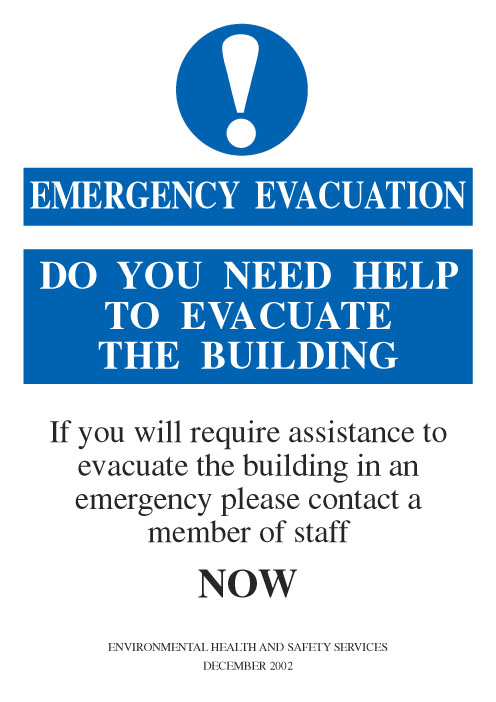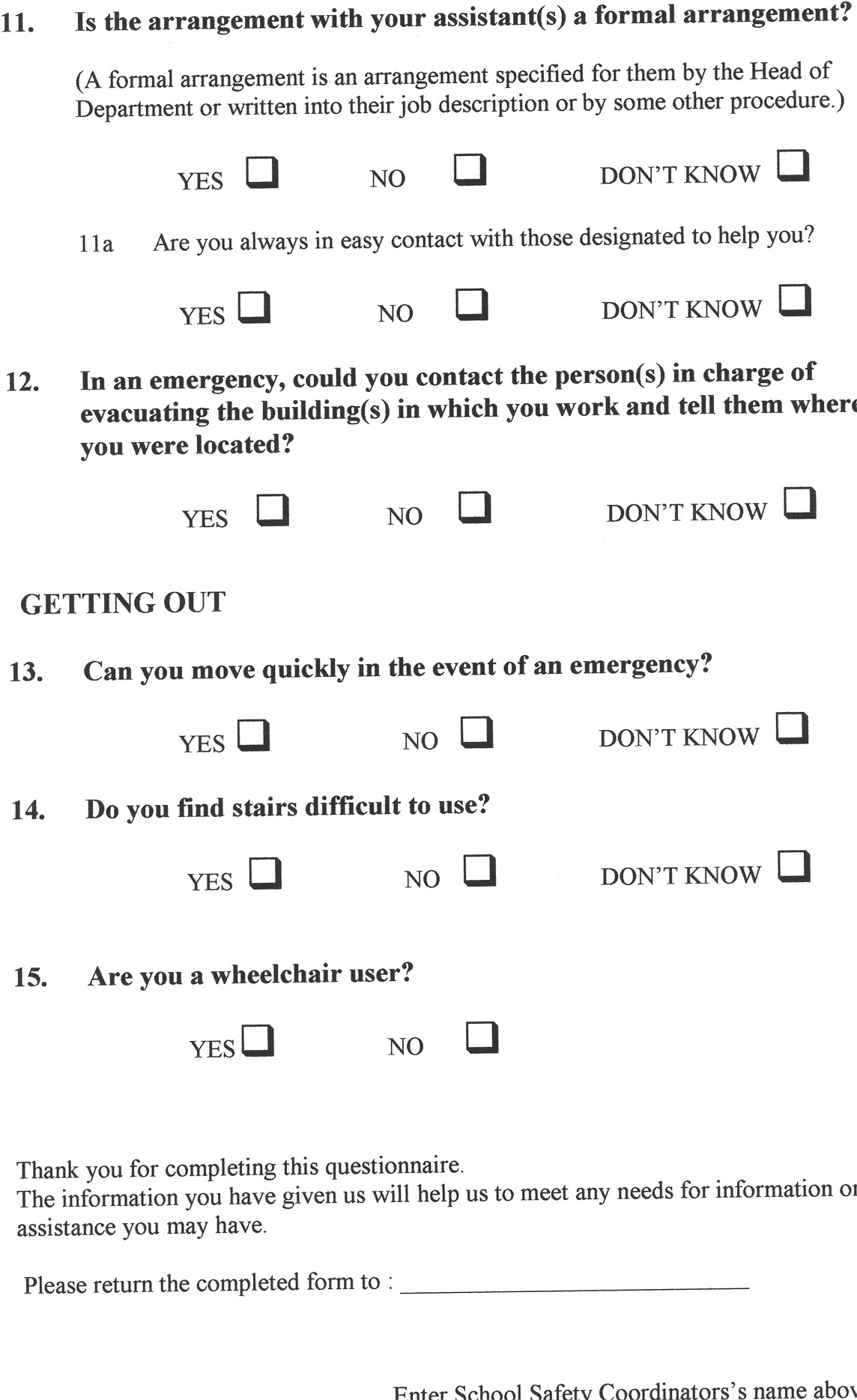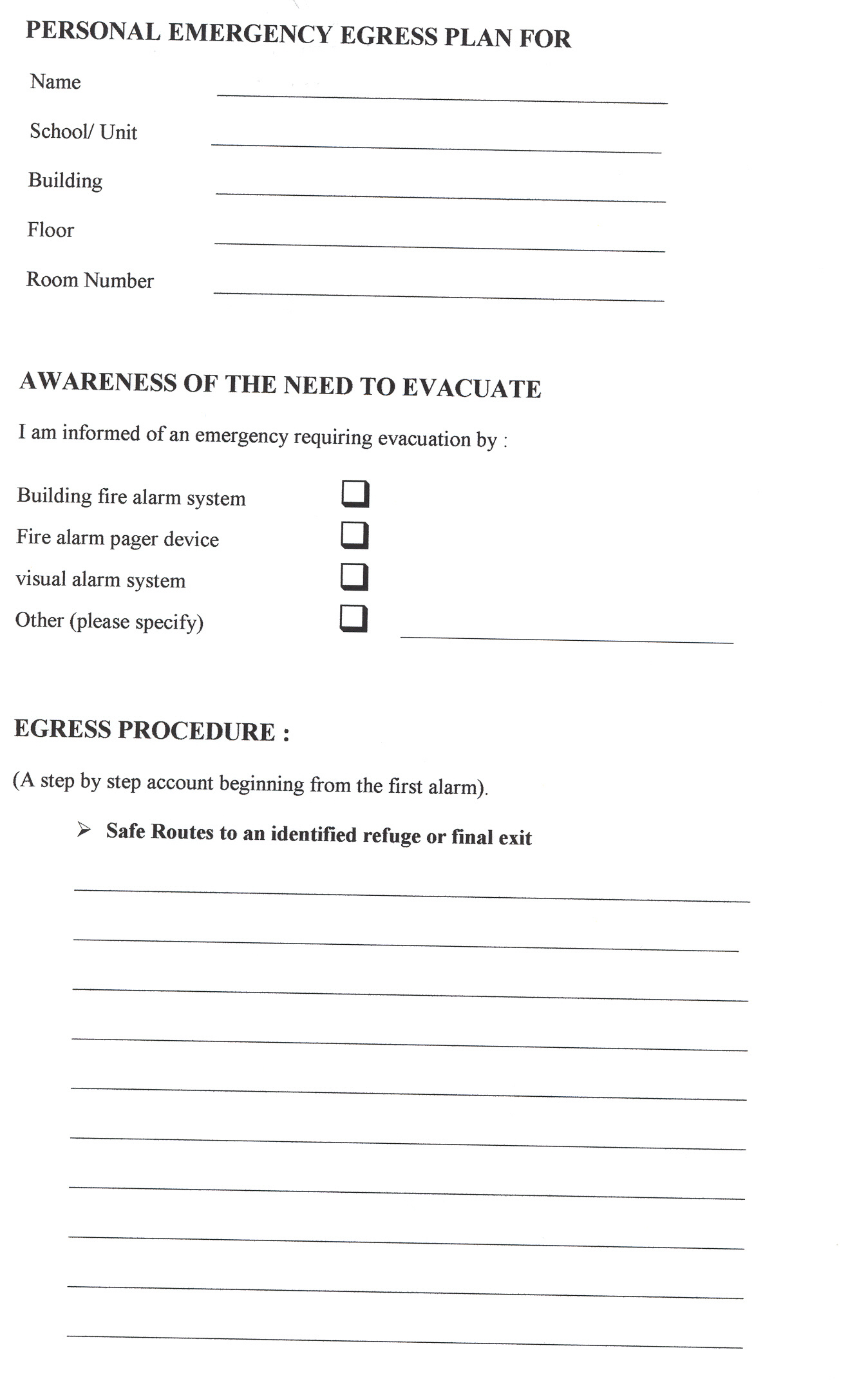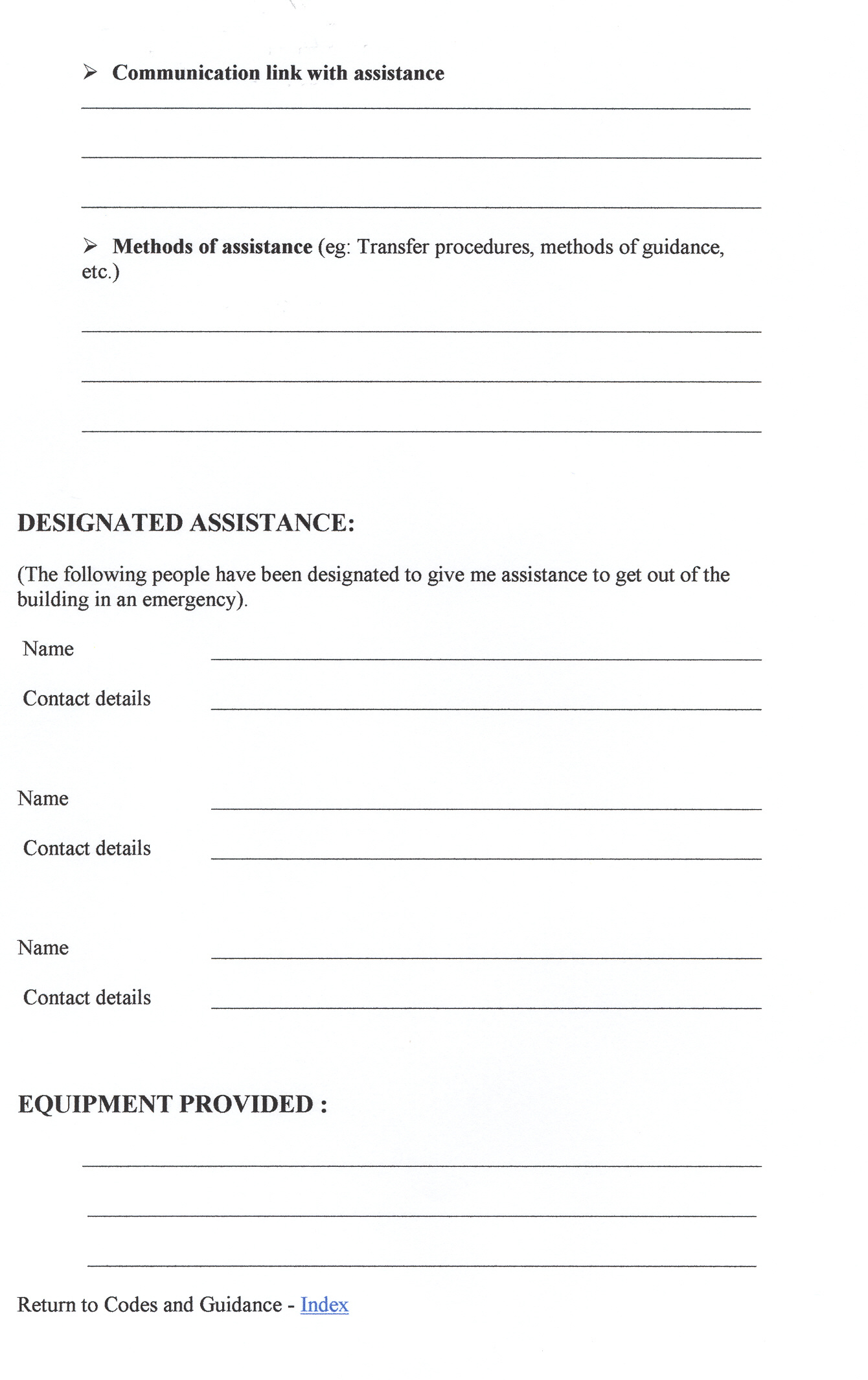Codes and Guidance
FIRE SAFETY GUIDANCE NOTE 1
Guidance on the Safe Evacuation of Persons Who May Require Assistance. (Revised: May 2004)
Contents
1. Introduction
2. Legislation
3. Definitions
4. Evacuation Procedures
5. Fire Evacuation Procedures - General Guidance
- Provision of Accommodation;
- Upper Floors - Evacuation Procedures;
- Factors Governing Which Method to Use;
- Use of Lifts.
- Evacuation Procedures - Assisting People with Impaired Mobility;
- Evacuation Procedures - Assisting People with Impaired Vision;
- Evacuation Procedures - Assisting People with Impaired Hearing
APPENDIX 1 - Definitions
APPENDIX 2 - Emergency Evacuation Notice
APPENDIX 3 - Emergency EGRESS Questionaire for Disabled Staff/Students
-------------------------------------------------------------------------------------------------
Introduction
This guidance note has been prepared to provide advice and guidance to Heads of Schools / Units for the safe evacuation in the event of an emergency, for staff, students and others who for what ever reason, will require assistance to leave the building.
This guidance note is not exhaustive and it will be the responsibility of the Head of School / Unit to ensure that reasonable measures are in place for the safe evacuation of persons requiring assistance.
Legislation
The Fire Precautions (Workplace) Regulations 1997 (as amended 1999) requires provision to be made for the safe evacuation of people from a building in the event of an emergency situation.
The Disability Discrimination Act 1995 and The Special Educational Needs and Disability Act 2001 require that disabled people including students should not be treated less favourably without justification, for a reason which relates to their disability. Reasonable adjustments should be made to ensure that people who are disabled are not put at a substantial disadvantage compared to people who are not disabled.
It is essential that special needs of any employee, student or visitor to University premises be taken into account when planning fire safety arrangements and evacuation procedures.
However, an appropriate method of evacuation can only be arrived at after discussion with the individual and due consideration of their needs.
Definitions
The following phrases are explained in Appendix 1;
- Protected Escape Route,
- Refuges,
- Evacuation Chairs (EVAC Chairs)
- Buddy System
Evacuation Procedures
Recommended Actions by Heads of School / Units
It is expected that Heads of School / Units will establish:
- A procedure whereby all members of staff, students and members of the public will be informed, by appropriate means, of the need for safety arrangements which should be in place for persons who may require assistance to evacuate the building. Appropriate means of communication can include the arrangements being given in the local health and safety policy and a notice being displayed within a building, (See Appendix 2).
These notices are available from Environmental Health and Safety Services.
- A procedure where the Heads of School / Units or an appropriate nominated person, will engage in dialogue with the person concerned and agree a procedure for their safe evacuation (See Appendix 3).
Where agreement cannot be reached, external advice and information should be sought from the University Environmental Health and Safety Services Office.
Implement and incorporate agreed measures into the premises fire evacuation procedures and update fire action plans;
- Identify the need for and arrange the provision of any necessary equipment;
- Arrange regular staff training in the procedures and use of equipment;
- Continue to assess and review evacuation procedures in premises under their control to which disabled persons have access.
The University Environmental Health and Safety Services Office is available to assist when required by Heads of School / Units.
Actions by Persons Requiring Assistance
It is expected that, on entering the building for the first time, a person who for any reason will require assistance:
- Should familiarise themselves with the established procedures of the building. (Fire action notices detailing this procedure are sited throughout the building);
- Contact a member of staff to arrange for the appropriate nominated person to discuss an agreed fire evacuation plan;
- Co-operate with the agreed managerial procedures for safe evacuation in the event of fire.
Fire Evacuation Procedures - General Guidance
Provision of Accommodation
The University may have to take account of the special needs of persons who may experience difficulties evacuating the workplace (particularly in an emergency).
Where persons, who may require assistance are employed within premises, consideration should be given to allocating accommodation, if this is reasonably practical, at ground floor level, as this will help make evacuation easier to achieve by avoiding the need to use stairs or lifts.
At this level, these persons would be able to evacuate the premise, with limited assistance, using the nearest available fire exit. If they have to move at a slower pace they should allow other persons to exit the building before them and then continue their evacuation to a place of safety.
Upper Floors - Evacuation Procedures.
The means of escape from university premises is based on the principle that members of staff, students and visitors can reach a protected enclosure within a defined travel distance and within 2.5 /3 minutes, from where they can proceed to the final exit in safety.
Whilst the majority of persons with special need can achieve this independently, a member of staff should escort those persons who may require assistance to a refuge. Once all able-bodied persons have evacuated the building, the person requiring assistance can be evacuated in a controlled and safe manner.
People requiring assistance can be evacuated from a refuge in a number of ways:
- Walk out themselves with limited assistance;
- Walk out with greater assistance (two or more members of staff assisting);
- In a wheelchair with limited assistance;
- With the assistance of specialised equipment (evacuation chair)
Factors governing which method to use.
Deciding on which method to use may depend on the following:
- The height of the building (the number of floors a person may require to be evacuated will decide if specialised equipment is required);
- The availability of staff (those who are suitably trained in the use of specialised equipment);
- Size and suitability of the stairs (does the stair width or design inhibit safe rescue?)
There may be occasions when the Fire Service will be in attendance and they may assist in the evacuation of persons with special needs. However when producing a fire evacuation procedure the use of Fire Service personnel should not be relied upon.
Use of Lifts
The use of a normal passenger or goods lift for evacuation purposes should not be permitted, as it is possible that persons may become trapped within the lift itself. The only type of lift, which can be used for evacuation purposes, is a fire-fighting lift or an evacuation lift designed and installed in compliance with the relevant British Standards. At the present time there are no fire fighting or evacuation lifts in University of St.Andrews premises.
Points for Consideration
Evacuation Procedures - Assisting people with impaired mobility.
In drawing up an evacuation plan, consideration should be given to the needs of persons with impaired mobility. If people use a wheelchair, or can only move about with the use of walking aids, their disability is obvious. However, disabilities can sometimes be less obvious than this and staff should be vigilant in an emergency, so that help can be given to those members of the public who need it most, including the very young and the elderly.
With a number of individuals, their impaired mobility may only be temporary. Members of staff in the advanced stages of pregnancy or with broken limbs will only be temporarily affected, but consideration must be given to their special needs in your emergency plan.
Person with walking aids and impaired mobility.
- Introduce the 'Buddy System' where a friend, colleague or member of staff will accompany the person to a protected enclosure;
- Be prepared to allow able bodied persons to evacuate the premises first;
- Be prepared to travel at a rate that is comfortable to the person with impaired mobility;
- Assess the need for specialised equipment.
Wheelchair Users.
- Fire exits which are wheelchair accessible should have clear signage so that they are easily identifiable by the wheelchair user.
- Identify a locations for wheelchair refuges and means of communication ;
- Identify if a wheelchair user can reach the refuge unaided. If not consider the introduction of the 'Buddy System';
- Identify the best method of evacuation or if there is a need for the provision of specialised equipment;
- As wheelchair users are experienced in transferring from the wheelchair to other forms of seating, they should be allowed to determine the method for transferring from the wheelchair to the specialised equipment.
Evacuation Procedures - Assisting people with impaired vision
Points for consideration.
- Fire Safety Signs. - People with impaired vision or colour perception may experience difficulty in seeing or recognising fire safety signs. Fire safety signs should be sufficiently large and well designed with a good, clear typeface and sited so that they can be seen easily and are readily distinguishable.
- Familiar with escape routes. - Staff/students with impaired vision should be familiarised with escape routes, especially those that are not in general use. Evacuation of a Premise. - In an evacuation of a building, a sighted person should lead those members of staff with impaired vision to safety. It is recommended that a sighted person should lead, inviting the other person to grasp their elbow, as this will enable the person being assisted to walk half a step behind and thereby gain information about doors and steps etc. Similar assistance should be offered to guide dog owners, with the owner retaining control of their dog.
- A normally sighted person should remain with staff with impaired vision until the emergency is over.
Good lighting and the use of simple colour contrasts can also help visually impaired people find their way around.
Advice about this can be obtained from the Royal National Institute for the Blind, the National Federation of the Blind of the United Kingdom., the Disabilities Advisor, Student Services and Environmental Health and Safety Services.
Evacuation Procedures - Assisting people with impaired hearing.
Whilst it is recognised that persons with impaired hearing will be able to make their way to a place of safety independently, difficulties may be encountered in identifying the fire alarm. Consideration should be given to the following:
- Is the person a sole worker (identifying the need for specialised equipment, i.e. flashing lights inter-linked to the fire alarm)?
- Is it possible for a colleague or other member of staff to ensure that the person with impaired hearing has been alerted?
- If in sleeping accommodation, is there a need for additional specialised equipment.
Further advice can be obtained from the Royal National Institute for Deaf People, the Student Services Disabilities Advisor, and Environmental Health and Safety Services.
Note: Where it is known that, for whatever reason, a person has not evacuated a building, this information must be passed to the fire service on their arrival.
APPENDIX 1.
Definitions.
Protected Escape Route
A protected escape route may consist of a corridor or stair enclosure which, once entered, will lead directly to a place of safety via. an emergency exit.
The escape route is separated from the rest of a building by fire-resisting construction, providing a minimum fire resistance of 60 minutes. Access to the escape routes is by 'Fire Doors' which provide a minimum fire resistance of 30 minutes. These doors are fitted with self-closing devices capable of closing the doors from all angles of swing.
Once inside a protected escape route, you are deemed to be in a place of safety.
In order to maintain a satisfactory standard Heads of Schools / Units must give consideration to the following:
- No combustible material should be stored or sighted within protected stair enclosure. (Open notice boards, paper/cardboard stored below stairs etc.)
- Stairways and corridors to be kept free from obstruction. (No siting of equipment within these areas)
- A programme of inspection to ensure that all fire doors function properly and that any defects are immediately identified and repaired.
Refuges
A refuge is an area normally sited within an enclosure such as a protected lobby, protected corridor or protected stairway, which provides a temporary safe area for people who will not be able to use stairways without assistance.
The refuge normally needs to be big enough to allow wheelchair use and to allow the user to manoeuvre into the wheelchair space without undue difficulty.
A means of communication must be provided so that the person requiring assistance can make contact with those people who have been designated to provide assistance. This could be by fixed telephone at the refuge point, mobile phone, or two way radio link.
It is essential that the location of any wheelchair spaces within a corridor or stair enclosure does not adversely affect the means of escape for other people by narrowing the escape route width.
In circumstances where the refuge area identified for a wheelchair user may restrict the free passage of others trying to evacuate the building, the area may still be suitable for use as a refuge providing that the wheelchair is manoeuvred into position after other persons have left that part of the building.
Evacuation Chairs (EVAC Chairs)
Evacuation chairs are specially designed chairs for the evacuation of a person down a stair enclosure in a controlled and safe manner.
Whilst they are primarily for the use of wheelchair users, they can also be of assistance to those with impaired mobility, chronic/asthmatic conditions etc.
They must only be operated by person(s) trained in their use.
Buddy System
The 'Buddy System' is a procedure whereby a friend, colleague or staff member is allocated the responsibility of ensuring that the person, who may require assistance, is alerted of the need to evacuate a building and may assist that person in the evacuation.
Normally the person allocated this responsibility will be employed within the vicinity or work area of the person requiring assistance.
In order to maintain the continuity of the evacuation procedures, persons should be nominated to deputise for those allocated the responsibility in their absence.
APPENDIX 2
This appendix can be downloaded as an Adobe Acrobat (.pdf) file -

This appendix can be downloaded as an Adobe Acrobat (.pdf) file -
APPENDIX 3
Emergency Egress Questionnaire for Disabled Staff / Students
This questionnaire can be down loaded as a Adobe Acrobat File (.pdf file) - Emergency Egress Questionnaire for Disabled Staff / Students (PDF, 729 KB)






This questionnaire can be down loaded as an Adobe Acrobat file (.pdf file) - Emergency Egress Questionnaire for Disabled Staff / Students (PDF, 729 KB)
